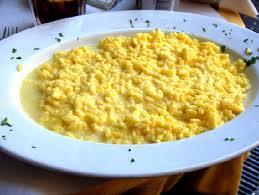Saffron is a spice which comes from the flower commonly known as the Saffron Crocus. Each stem carries up to four flowers, each with three vivid crimson stigmas.
 |
| Saffron Crocus |
Together with the stalks that connect the stigmas to their host plant, the dried stigmas have been used for centuries in various cuisines as a seasoning and colouring agent, as well as a dye for materials. It is native to southwest Asia and was first cultivated in Greece. It is one of the world’s most costly spices in weight, as the flower’s stigmas need to be collected by hand. One thousand five hundred flowers are needed to make one kilo of saffron spice. Iran now cultivates 90% of the world’s saffron.
 |
| Saffron fields in Iran |
In the 1300s, rice was extensively cultivated in the area around Naples. Due to the close political and parental relations between the Aragonese in Naples, and the rulers of Milan (the Visconti ruled Milan during the years 1277-1477, and afterwards the Sforza family) rice plantations made their way to northern Italy, where the plain of the Po river was particularly conducive to its success in cultivation. Risotto alla Milanese, which combines both saffron and rice, is thought to have originated in the 1500s. There are some fantastic legends explaining its origin. One of them tells of a very well known and talented glass maker from Flanders who had been called to Milan to work on the windows displaying the cycle of Saint Helen for the cathedral, who had a very talented young craftsman in his workshop, particularly talented in the rendering of colours. His nickname was ‘saffron’ as he put a tiny dose of the plant into the vitreous paste to achieve a brilliant yellow. When his master’s daughter was getting married, in order to increase the magnificence and spectacle at the wedding feast, he did the same for the risotto as for the stained glass windows and added some saffron to the rice, and the rest is history!
Costoletta alla Milanese (called cotoletta alla Milanese by the locals) – is another one of the staples of Milanese cuisine. The name means ‘little rib’ because of the rib that remains attached to the meat during and after cooking. The veal cutlet is breaded and browned in butter.
 |
| Costoletta alla Milanese |
This of course immediately reminds many of us of the Weiner schnitzel.
Milan, as well as most of northern Italy, was under Austrian rule for most of the 18th and 19th centuries, after the treaty of Utrecht in 1713, which ended the war of the Spanish succession and assigned Spain’s Italian possession to Austria. Both the northern Italians and the Austrians exchanged cultural and culinerary practices. It is maintained that the Austrians imported the cotoletta alla Milanese to their native land, and not the other way round. The Weiner Schnitzel (Viennese Schnitzel) differs in that there is no bone, and it is thinner and typically crunchier.
 |
| Weiner Schnitzel – the Viennese schnitzel |
The cotoletta a orecchio di elefante (elephant ear cutlet) is a slight variation also found in Milan, using a thinner larger cut of meat, deboned and tenderized prior to frying. It is called ‘elephant ear’ due to its shape.
Ossobuco – the name translates into ‘bone with a hole’, a reference to the marrow hole on the centre of the cross-cut veal shank.
 |
| Raw cross cut veal shank showing the marrow bone |
It was first documented in the 1800s. Most recipes start by browning the veal shanks in butter (some recommend vegetable oil or lard) after dredging them in flour. The braising liquid is usually a combination of white wine and meat broth flavoured with vegetables. The shanks are cooked in a low heat for 1-1.5 hours. Five minutes before the end of the cooking time, the gremolata is added (a chopped herb condiment of parsley, lemon zest and garlic).
Ossobuco is often served with
risotto alla Milanese, or creamy polenta.
 |
| Ossobuco with risotto alla Milanese |
Cassoeula – is a great winter dish. It is a thick hearty pork, sausage and cabbage soup.
 |
| Cassoeula |
Variations with the pork cuts can occur depending upon taste (trotters, ribs, rind, head, intestines) and sometimes, in the countryside, variations of the type of meat such as chicken or goose. Either way, they all share the common ingredient of cabbage.
Finally, the national Italian Christmas cake, the Panettone, is originally from Milan.
 |
| Panettone |
One charming story as to the origins of this traditional Christmas cake dates to 1495, when the head cook of Ludovico il Moro, Duke of Milan, having too many things to organise for the sumptuous Christmas dinner for the duke and his guests, burnt the cake that was for dessert. A kitchen hand, called Toni, had made a cake that morning with the remains of the ingredients used for all the other meal’s dishes (flour, butter, egg, lime peel and some raisins. Toni presented his creation to the cook, who in desperation took the strange cake, in the shape of a large bread loaf, to the duke’s table. Proving to be a huge success, all the guests wanted to know the name, to which the chef replied that it was ‘Toni’s bread’ or Pan di Toni, which morphed, over time, intopanettone.
Another explanation for the origin of panettone is documented by Count Pietri Verri, who described the ceremony of the breaking of bread that both rich and poor families would perform at Christmas time. The ‘ceremonia del Ceppo’ would be when the whole family would gather together and the head of the family would break a loaf of bread into pieces, enough for each member, so that all would share from the same loaf, symbolic of the strong family ties which bind all together. The poor man’s bread was made from millet (pane di miglio, called ‘pan de mej’), and the bread of the wealthy and nobility was white bread (called micca). It was decided however that on Christmas day everybody should use the same bread as in the Ceremonia del Ceppo, as a symbol of equality and togetherness. This bread, made from butter, pure flour and sugar was called the pan de’ sciori or pan de ton meaning the luxury bread. In 1919, Motta, the Milanese company, produced the first industrial panettone.















